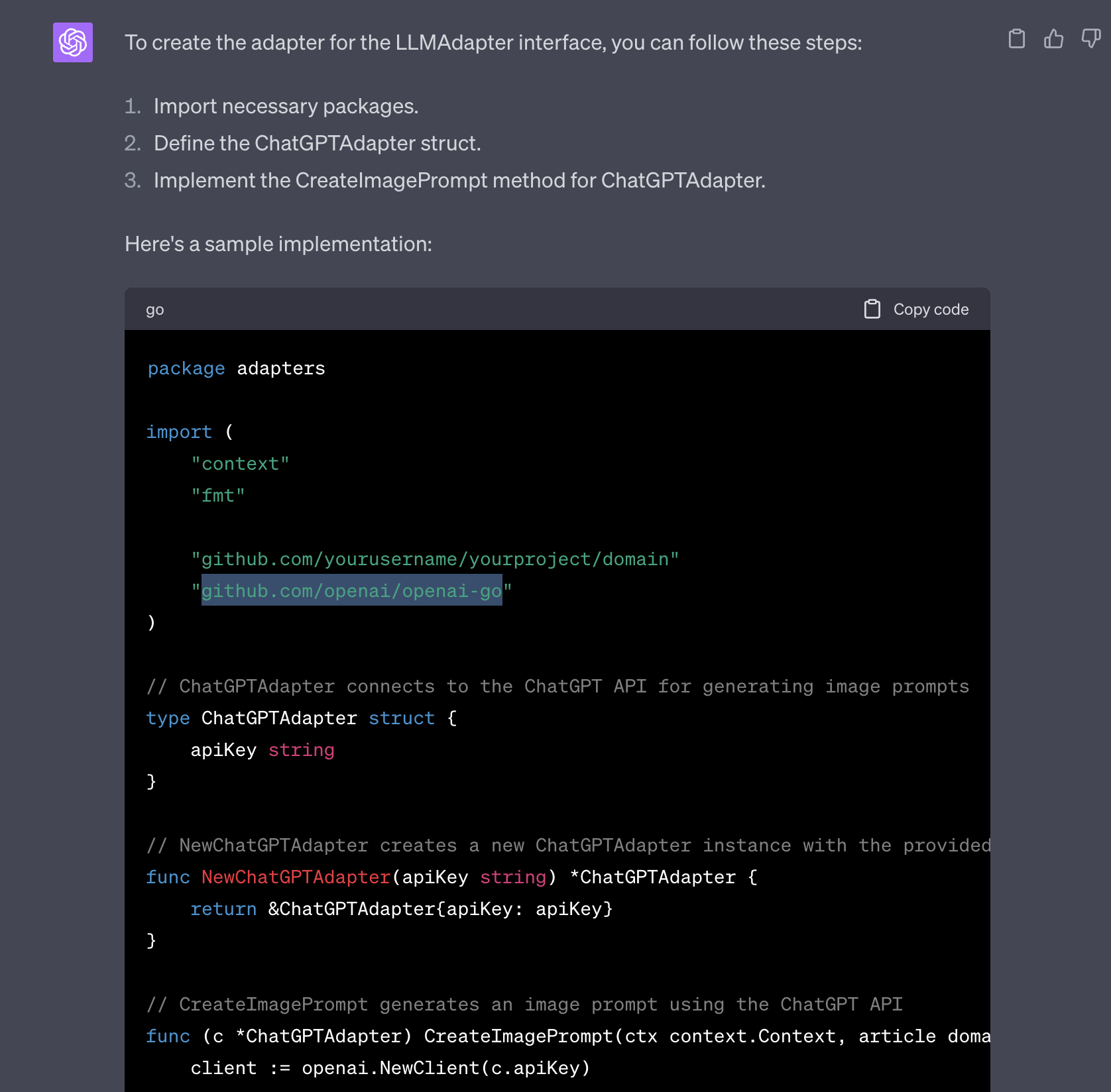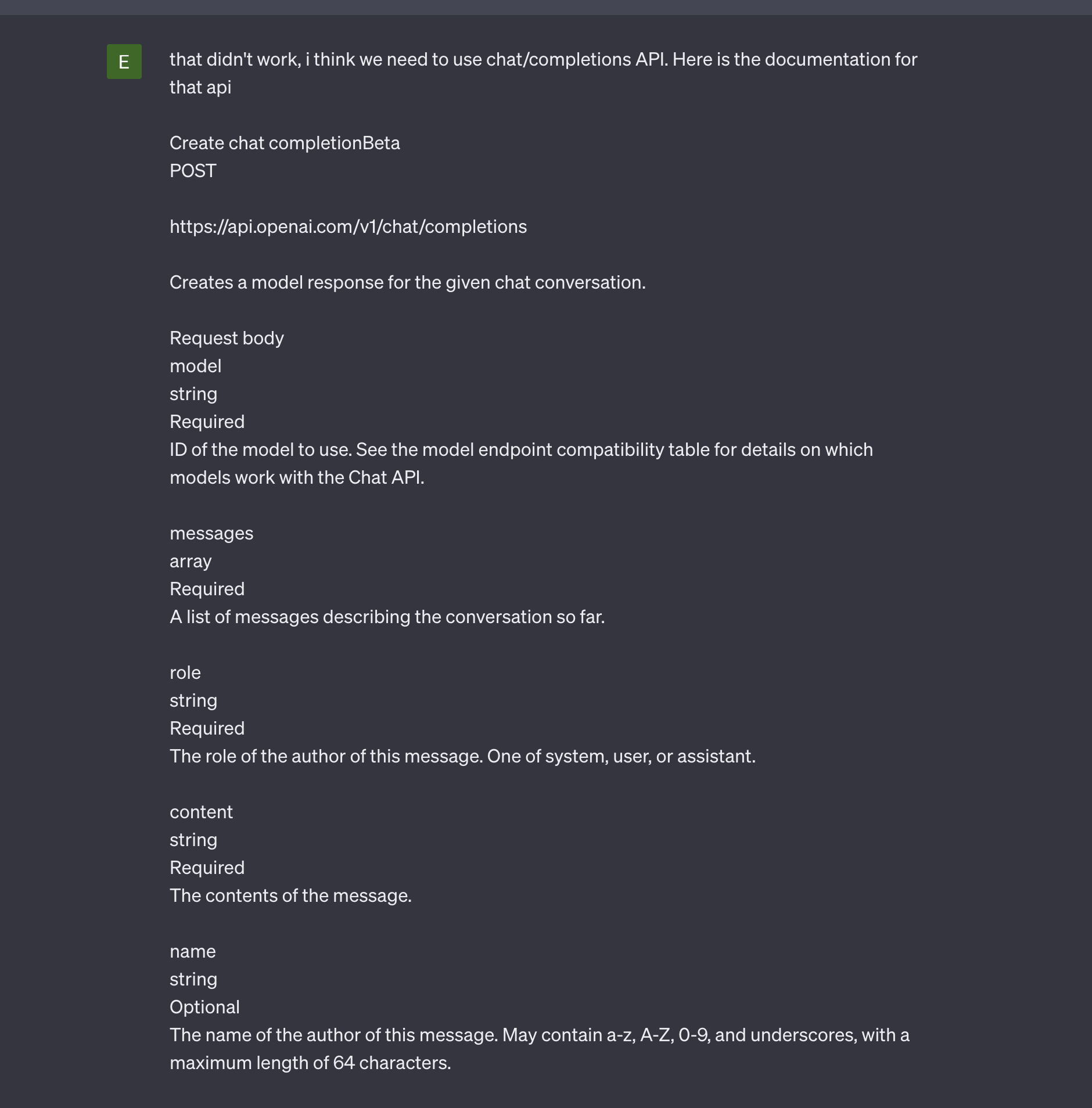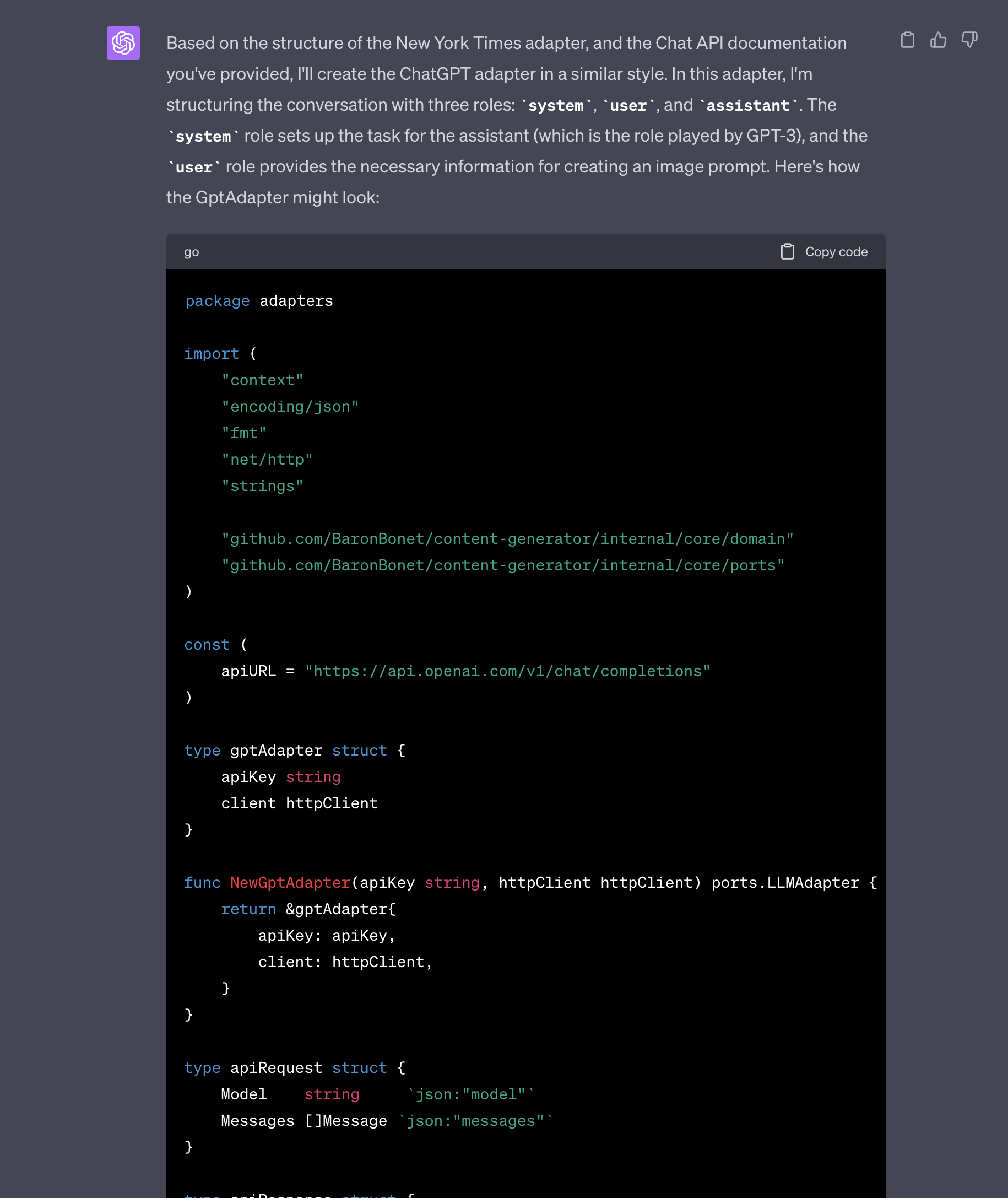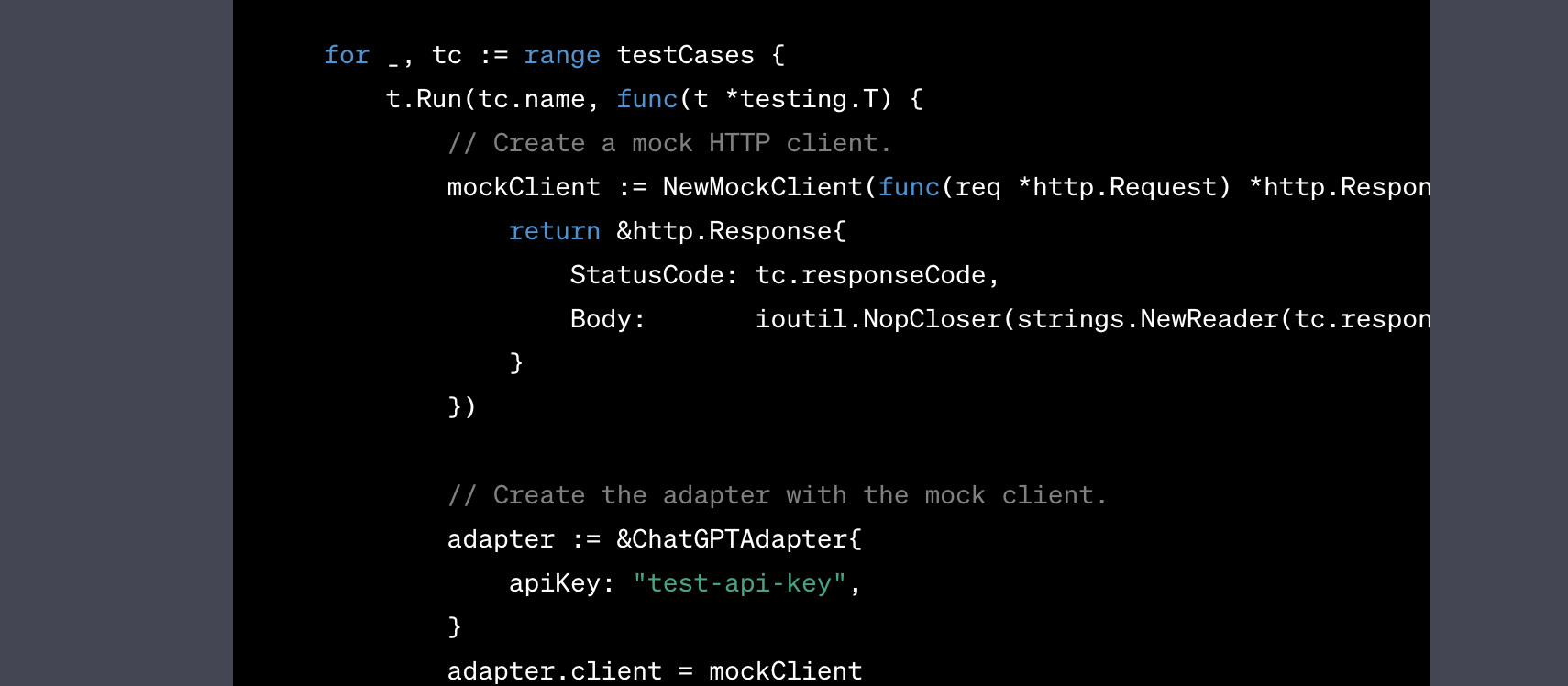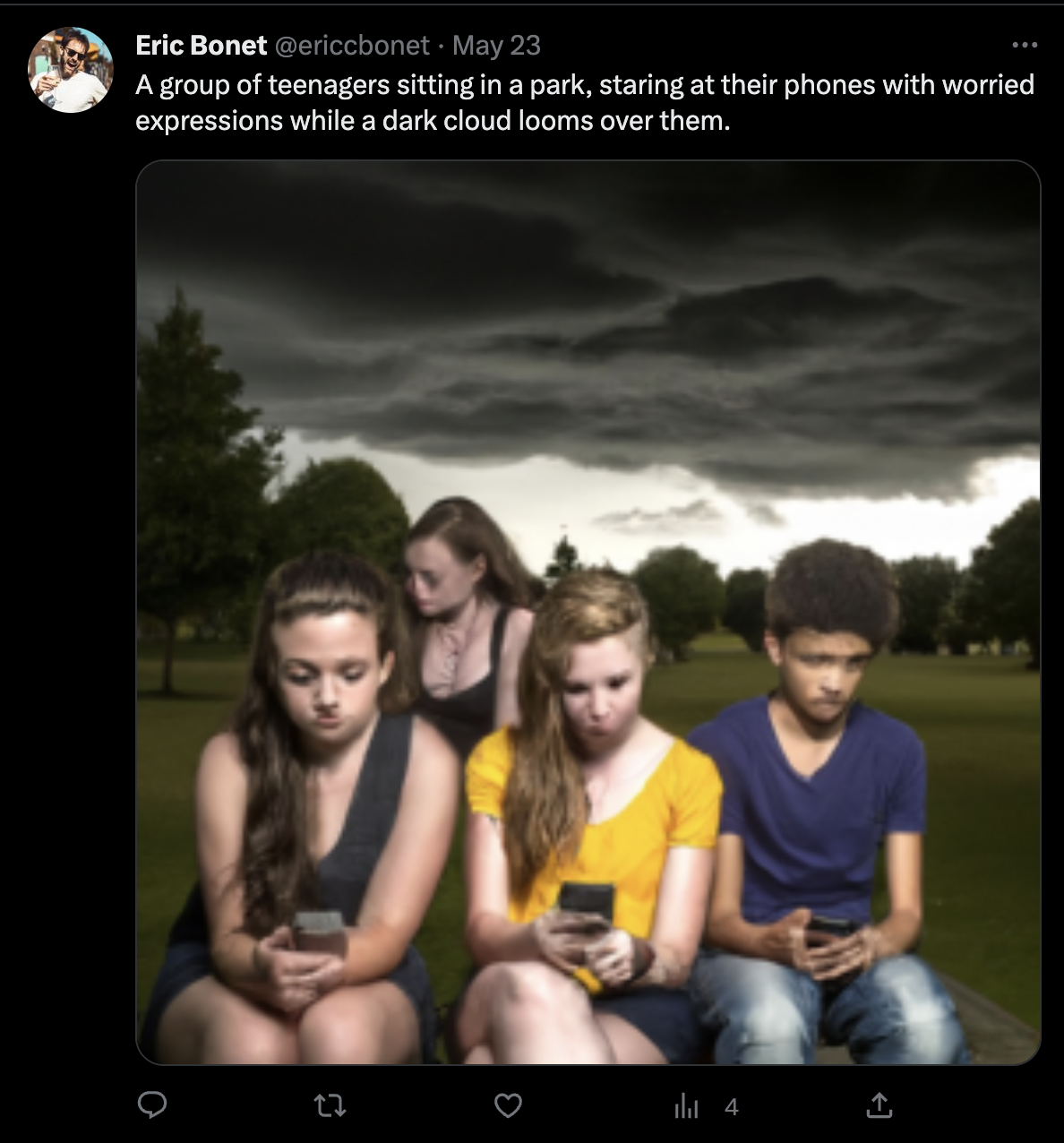Hex Architecture & ChatGPT - Part 3, Adapters for ChatGPT, DALL-E and Twitter
In part 2 of this series we implemented our first adapter, the New York Times adapter, and it went really smooth. In this post I’ll share my experience with implementing the other 3 adapters:
- ChatGPT - Large Language Model Adapter
- DALL-E - Image Generation Adapter
- Twitter - Social Media Adapter
Spoiler alert, it didn’t go as smooth and ChatGPT often reminded me it’s knowledge cut-off in September 2021.
What went wrong
Using the same style of prompt as we did in part 2 I asked ChatGPT to create the LLMAdapter.
I am working on a go project that follows the principals> of hexagonal architecture
I need you to create the adapter for this port
// LLMAdapter is responsible for connecting to large > language models like ChatGPT type LLMAdapter interface { // CreateImagePrompt creates a prompt that an AI image> generator can use CreateImagePrompt(ctx context.Context, article > domain.NewsArticle) (domain.ImagePrompt, error) } package domain import "time" type NewsArticle struct { Title string Body string Date Date } type Date struct { Day int Month time.Month Year int } type ImagePrompt string type ImagePath stringThe adapter should connect to the chatGPT api and ask it to create a prompt for an image generation tool
ChatGPT ‘hallucinated’ and ended up creating an adapter using a package that didn’t exist github.com/openai/openai-go. In hindsight this obviously wasn’t going to work, ChatGPT most likely had no way of reading its API documentation when it was being trained.
Teaching ChatGPT about itself
This clearly wasn’t going to be as easy as the New York Times API. Building this adapter would require reading part of the ChatGPT documentation…but not much of it. I ended up sending a long prompt to ChatGPT, I won’t copy the entire prompt below, but it consistency of 3 parts.
“that didn’t work, I think we need to use chat/completions API. Here is the documentation for that api”
- I copy-pasted all the documentation from [Completion](https://platform.openai. com/docs/api-reference/completions)
- “Here is another example request from the API docs”
- I found another example of the completions api being used and copy-pasted it for more context (not sure if this was necessary)
- “Could you write the Adapter in the same style as the following news adapter”
- I copied the NewsAdapter it already wrote, so it had an example to follow
This worked significantly better. It was implemented using the default Golang http client package. Once it was wired up in debugger/main.go it actually functioned. Granted the prompt it generated needed some work, but this is something I can play with once the adapters are finished.
Tests
With the knowledge that the adapter functioned it was time for ChatGPT to write tests for the adapter. I copied the entire newsadapter_nytimes_test.go file for an example. The test it returned were good enough that with little effort they functioned.
At this point I felt the tests were getting a bit sloppy, because both adapter tests had the same code for mocking the http client. Also, I would have preferred if the test it generated for the ChatGPTAdapter used the NewChatGPTAdapter function for instantiating the adapter .
To fix this I created a httpClient interface and again used mockery to generate the boilerplate code.
package adapters
import "net/http"
// httpClient is an interface that represents an HTTP client.
// This exists, so we can mock the HTTP client, which is used in multiple adapters in our tests.
//
//go:generate mockery --name=httpClient
type httpClient interface {
Do(req *http.Request) (*http.Response, error)
}
I think the tests became cleaner with this format. The two changes I had to make were:
- Swap out how the mock client was created, since we’re now leveraging the generated code.
- Create a new instance of the ChatGPTAdapter with the
NewchatGPTAdapterfunction.
for _, tc := range testCases {
t.Run(tc.name, func(t *testing.T) {
mockClient := newMockHttpClient(t)
mockClient.On("Do", mock.Anything).Return(&http.Response{
StatusCode: tc.responseCode,
Body: ioutil.NopCloser(strings.NewReader(tc.responseBody)),
}, nil)
adapter := NewChatGPTAdapter("test-api-key", mockClient)
_, err := adapter.CreateImagePrompt(context.Background(), domain.NewsArticle{Title: "test", Body: "test"})
if (err != nil && tc.expectedError == nil) ||
(err == nil && tc.expectedError != nil) ||
(err != nil && tc.expectedError != nil && err.Error() != tc.expectedError.Error()) {
t.Errorf("Expected error: %v, got: %v", tc.expectedError, err)
}
})
}
Prompt ChatGPT with API documentation
I follow a similar prompting workflow for creating both the DalleImageGenerationAdapter and the TwitterSocialMediaAdapter:
- Introducing the project by stating I am creating a Golang project using Hexagonal Architecture
- Ask for it to create an adapter that implements a port, copy the code for the port and any relevant domain information.
- Copy-paste the documentation of the external API the adapter will need to communicate with and an example of the API being used. Basically try to paste as much relevant content into the ChatGPT UI as it will allow.
This worked very well for the DALL-E adapter. With minimum modification I could use the code ChatGPT gave me. However, the Twitter Adapter was more complex. The adapter ended up using 2 versions of the api v1.1 for upload an image and getting a media ID and v2 for creating the actual tweet. I sent more than 20 prompts to ChatGPT, and had to modify a lot of the code it provided me. In the end, building this the “old fashion” way (reading documentation and stack overflow) probably would have been faster as less frustrating.
Try the service
Up until now I have yet to use the actual service. I’ve been wiring up each adapter individually to test with the debugger. So let’s modify cmd/debugger/main.go, which I’m basically using as a scratch pad to test the entire service.
package main
import (
"context"
"github.com/BaronBonet/content-generator/internal/adapters"
"github.com/BaronBonet/content-generator/internal/core/service"
"go.uber.org/zap"
"net/http"
"os"
"time"
)
func main() {
logger := adapters.NewZapLogger(zap.NewDevelopmentConfig(), true)
NYTimesKey, exists := os.LookupEnv("NEW_YORK_TIMES_KEY")
if !exists {
logger.Fatal("NEW_YORK_TIMES_KEY not found")
}
newsAdapter := adapters.NewNYTimesNewsAdapter(NYTimesKey, http.DefaultClient)
OpenAIKey, exists := os.LookupEnv("OPENAI_KEY")
if !exists {
logger.Fatal("OPENAI_KEY not found")
}
llmAdapter := adapters.NewChatGPTAdapter(OpenAIKey, http.DefaultClient)
imageGenerationAdapter := adapters.NewDalleImageGenerationAdapter(OpenAIKey, http.DefaultClient)
socialMediaAdapter, err := adapters.NewTwitterAdapterFromEnv()
if err != nil {
logger.Fatal("Error when creating twitter adapter", "error", err)
}
contentService := service.NewNewsContentService(logger, newsAdapter, llmAdapter, imageGenerationAdapter, socialMediaAdapter)
ctx, cancel := context.WithTimeout(context.Background(), 20*time.Second)
defer cancel()
err = contentService.GenerateNewsContent(ctx)
if err != nil {
logger.Fatal("Error when generating news content", "error", err)
}
}
It worked! My first AI generated tweet and image was created, although slightly depressing.
Conclusion
We now have the main functionality off the app complete. My main learning points in creating these adapters are:
- It’s been almost 2 years since ChatGPT was trained so give it as much up-to-date content as possible.
- Give up on trying to get ChatGPT to build the thing for you (and just do it yourself) if it keeps failing after a few prompts. I was getting pretty frustrated by the responses it was giving me when trying to get it to make the Twitter adapter, I should have quit much earlier.
Current state of the project
├── cmd
│ └── debugger
│ └── main.go
├── go.mod
├── go.sum
└── internal
├── adapters
│ ├── http_client.go
│ ├── imagegenerationadapter_dalle.go
│ ├── imagegenerationadapter_dalle_test.go
│ ├── llmadapter_chatgpt.go
│ ├── llmadapter_chatgpt_test.go
│ ├── newsadapter_nytimes.go
│ ├── newsadapter_nytimes_test.go
│ ├── socialmediaadapter_twitter.go
│ ├── socialmediaadapter_twitter_test.go
│ └── zap_logger.go
├── core
│ ├── domain
│ │ └── domain.go
│ ├── ports
│ │ ├── driven.go
│ │ ├── infrastructure.go
│ │ └── service.go
│ └── service
│ ├── service.go
│ └── service_test.go
└── infrastructure
└── version.go
Note: I haven’t discussed internal/adapters/zap_logger.go or infrastructure/version.go. Zap logger implements the logging port defined in internal/core/ports/infrastructure.go. The version (the commit sha) is set when building the application and is passed to the logger when it’s instantiated.

